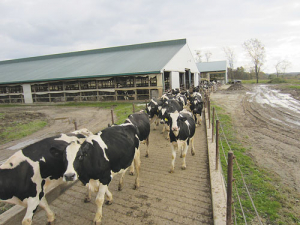Good cow flow is vital and at the heart of achieving efficient milkings.
As a bonus, steady quiet movement of cows through the milking process reduces time in the shed, stock and human stress, and the risk of cows withholding their milk or becoming lame.
The expert on cow flow, veterinarian Neil Chesterton, has observed that sheds with good cow flow achieve the following at peak:
Ten rounds or rows of cows should take no longer than 1.5h to milk. This is a great starting point and can be improved on by using efficient routines and strategies (see the sessions on milking skills and building blocks of milking efficiency).
It is a rule that can apply equally to a 200-cow herd milked through a 20-bail herringbone, or to a 500-cow herd milked on a 50-bail rotary. It doesn’t include the time taken to walk cows to and from the farm dairy.
Cows receive information via their senses just as humans do.
But being a prey animal, they process this information differently. Knowing this helps us work out why a cow does what she does.
Understanding what is important for a cow helps us to work with them rather than against them. Giving cows time to find their feet when walking up a race or stepping onto a yard are two such examples.
Cows moving steadily and quietly through a farm dairy are a pleasure to milk. Identifying the obstacles that prevent them from doing this will help improve cow flow. In particular, look for places where cows can hurt themselves (e.g. shiny steelwork).
What does cow flow tell you about the ‘temperature’ in your farm dairy? Are cows and people operating cool and calm or hot and flustered?
• Article: DairyNZ


















